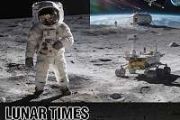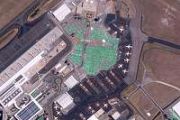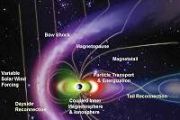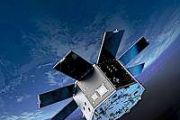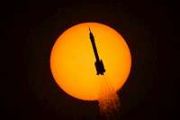
Copernical Team
Carbon's cosmic 'conveyer belt' across time and space
 Life on Earth could not exist without carbon. But carbon itself could not exist without stars. Nearly all elements except hydrogen and helium - including carbon, oxygen and iron - only exist because they were forged in stellar furnaces and later flung into the cosmos when their stars died. In an ultimate act of galactic recycling, planets like ours are formed by incorporating these star-built at
Life on Earth could not exist without carbon. But carbon itself could not exist without stars. Nearly all elements except hydrogen and helium - including carbon, oxygen and iron - only exist because they were forged in stellar furnaces and later flung into the cosmos when their stars died. In an ultimate act of galactic recycling, planets like ours are formed by incorporating these star-built at NASA's LEXI Will Provide X-Ray Vision of Earth's Magnetosphere
 A NASA X-ray imager is heading to the Moon as part of NASA's Artemis campaign, where it will capture the first global images of the magnetic field that shields Earth from solar radiation.
The Lunar Environment Heliospheric X-ray Imager, or LEXI, instrument is one of 10 payloads aboard the next lunar delivery through NASA's CLPS (Commercial Lunar Payload Services) initiative, set to launch
A NASA X-ray imager is heading to the Moon as part of NASA's Artemis campaign, where it will capture the first global images of the magnetic field that shields Earth from solar radiation.
The Lunar Environment Heliospheric X-ray Imager, or LEXI, instrument is one of 10 payloads aboard the next lunar delivery through NASA's CLPS (Commercial Lunar Payload Services) initiative, set to launch An autonomous strategy for life detection on icy worlds using Exo-AUV
 Icy moons like Europa and Enceladus offer intriguing environments for studying potential extraterrestrial life. These environments, particularly the icy shell, ice-water interface, and seafloor, are considered prime regions for identifying robust biosignatures, extant life, and prebiotic chemical systems. Extraterrestrial Autonomous Underwater Vehicles (Exo-AUVs) play a critical role in these ex
Icy moons like Europa and Enceladus offer intriguing environments for studying potential extraterrestrial life. These environments, particularly the icy shell, ice-water interface, and seafloor, are considered prime regions for identifying robust biosignatures, extant life, and prebiotic chemical systems. Extraterrestrial Autonomous Underwater Vehicles (Exo-AUVs) play a critical role in these ex UAH Electric Propulsion Club seeks patent for experimental ion thruster
 The Electric Propulsion Club (EPC) at The University of Alabama in Huntsville (UAH), recently traveled to Milan, Italy, to present STARGATE, an experimental gridded ion thruster developed by the group, at the 75th International Astronautical Congress (IAC). The group's STARGATE team consists entirely of UAH undergraduates and is an independent student research organization working in the fields
The Electric Propulsion Club (EPC) at The University of Alabama in Huntsville (UAH), recently traveled to Milan, Italy, to present STARGATE, an experimental gridded ion thruster developed by the group, at the 75th International Astronautical Congress (IAC). The group's STARGATE team consists entirely of UAH undergraduates and is an independent student research organization working in the fields UVA professor aims to boost next-generation space rockets
 Go faster, farther, more efficiently.
That's the goal driving spacecraft propulsion engineers like Chen Cui, a new assistant professor at the University of Virginia School of Engineering and Applied Science. Cui is exploring ways to improve electric propulsion thrusters - a key technology for future space missions.
"In order to ensure the technology remains viable for long-term missi
Go faster, farther, more efficiently.
That's the goal driving spacecraft propulsion engineers like Chen Cui, a new assistant professor at the University of Virginia School of Engineering and Applied Science. Cui is exploring ways to improve electric propulsion thrusters - a key technology for future space missions.
"In order to ensure the technology remains viable for long-term missi India unveils plans for 10 missions in 2025 after successful space-docking launch
 India's space agency says it is planning a record 10 orbital missions, as well as its first commercial effort, during 2025 after successfully launching a space-docking project this week.
Indian Space Research Organization chairman S. Somanath told reporters following Monday's launch of a PSLV-C60 rocket carrying Space Docking Experiment, or SpaDeX, payloads, that the nation has big plan
India's space agency says it is planning a record 10 orbital missions, as well as its first commercial effort, during 2025 after successfully launching a space-docking project this week.
Indian Space Research Organization chairman S. Somanath told reporters following Monday's launch of a PSLV-C60 rocket carrying Space Docking Experiment, or SpaDeX, payloads, that the nation has big plan See and hear three years of solar fireworks
 Video:
00:01:14
Video:
00:01:14
At the start of this new year, we look back at close-up pictures and solar flare data recorded by the ESA-led Solar Orbiter mission over the last three years. See and hear for yourself how the number of flares and their intensity increase, a clear sign of the Sun approaching the peak of the 11-year solar cycle.
This video combines ultraviolet images of the Sun's outer atmosphere (the corona, yellow) taken by Solar Orbiter's Extreme Ultraviolet Imager (EUI) instrument, with the size and locations of solar flares (blue circles) as recorded by the Spectrometer/Telescope for Imaging X-rays (STIX) instrument. The
Robot rock at LUNA
 Image:
Image:
ESA's robots get ready to rock at LUNA.
Also known as the Moon on Earth, the LUNA facility near the European Astronaut Centre (EAC) in Cologne, Germany, was unveiled in September 2024, a simulated lunar environment that prepares our return to the Moon. To celebrate, ESA astronaut Matthias Maurer joined forces with our robotics experts to showcase their cutting-edge machines Interact and Spot, and the potential of human-robot teamwork for space exploration.
Meet ESA’s robots: Interact, a wheeled robotic arm, and Spot, a robot dog. ESA’s robotics team in the Netherlands programs these machines for human-robot interaction experiments such as
Pale blue (supernova) dot
 Image:
Pale blue (supernova) dot
Image:
Pale blue (supernova) dot Chinese satellite network enhances maritime internet connectivity
 Spacesail Constellation, a Chinese commercial low-orbit satellite network, has successfully completed its inaugural network connection test, demonstrating the system's capability to support high-speed broadband services for maritime applications.
The test, conducted by Shanghai Spacesail Technologies Co., Ltd., assessed the ability of the satellite broadband network to deliver internet con
Spacesail Constellation, a Chinese commercial low-orbit satellite network, has successfully completed its inaugural network connection test, demonstrating the system's capability to support high-speed broadband services for maritime applications.
The test, conducted by Shanghai Spacesail Technologies Co., Ltd., assessed the ability of the satellite broadband network to deliver internet con 













